Sarah Sundin's Blog, page 279
December 9, 2016
Remember Pearl Harbor – Tour & Commemorative Giveaway – Day 3
 This week marks the 75th anniversary of the attack on Pearl Harbor that launched the United States into World War II. Last month I was privileged to visit Pearl Harbor with my husband. This week I’m sharing photographs from our visit, plus some historical background. In addition, I’m giving away some commemorative items from Pearl Harbor – the official 75th anniversary commemorative ornament, Pearl Harbor: The Way It Was by Scott C.S. Stone, and a pen.
This week marks the 75th anniversary of the attack on Pearl Harbor that launched the United States into World War II. Last month I was privileged to visit Pearl Harbor with my husband. This week I’m sharing photographs from our visit, plus some historical background. In addition, I’m giving away some commemorative items from Pearl Harbor – the official 75th anniversary commemorative ornament, Pearl Harbor: The Way It Was by Scott C.S. Stone, and a pen.
To enter the giveaway, leave a comment on any of the three posts or send me an email at sarah [at] sarahsundin [dot] com – you have three chances to win. The giveaway ends Sunday, December 11, 2016, and I’ll announce the winner here on my blog on Monday, December 12, 2016.
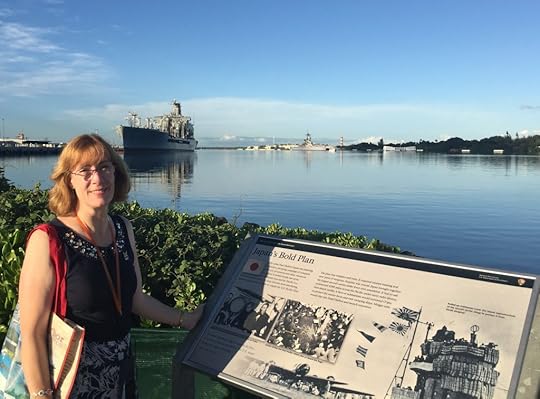
Sarah Sundin at Pearl Harbor, Hawaii, 7 Nov 2016 (Photo: Sarah Sundin)
I hope these posts help you reflect on the gravity of the attack and the sacrifice of the 2459 servicemen and civilians who died that day. Let’s never forget the lessons of that day.
On Monday I shared pictures from the Pacific Aviation Museum. On Wednesday, I shared from the USS Arizona Memorial, and today I’ll share about the submarine USS Bowfin and the battleship USS Missouri, where the Japanese signed the surrender documents officially ending World War II on Sept. 2, 1945.
World War II in the Pacific
While the Japanese attack on Pearl Harbor struck a devastating blow and caused a horrific loss of life, that tragic day wasn’t the end of the story. Five great battleships had been sunk, but two were raised and repaired. More importantly, none of America’s aircraft carriers were at Pearl Harbor. As time would tell, the naval battle in the Pacific would be dominated by the carriers, with the battleships slipping into obsolescence. Also, the Japanese called off the third wave of the Pearl Harbor attack, which was meant to demolish the dry docks and oil storage facilities. With those intact, the naval base was able to resume operations quickly.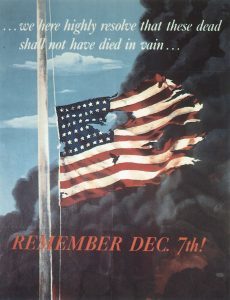
What the Japanese didn’t bargain on was how the attack would galvanize the American will. After years of bickering about whether or not to get involved in “another European war,” suddenly Americans were unified. Recruiting offices were flooded with young men enlisting, and the government, military, industry, and individual civilians turned with singular determination to winning the war.
The Pearl Harbor Historic Sites tell the story of that horrifying and fateful morning of December 7, 1941 – but they also continue the story, from tragedy to triumph. The Pacific Aviation Museum tells the role of aviation, from the brave little Cactus Air Force on Guadalcanal to the epic Battle of Midway. And the USS Bowfin and the USS Missouri focus on submarine warfare in the Pacific and on the end of the war.
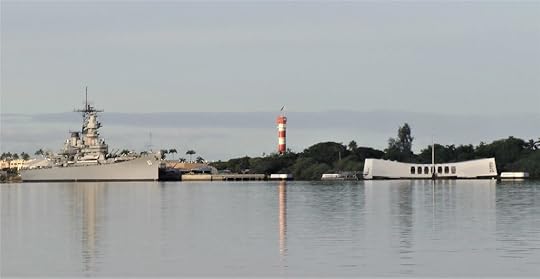
Pearl Harbor Historic Sites: USS Missouri, the control tower at the Pacific Aviation Museum, and the USS Arizona Memorial (Photo: David Sundin, 7 Nov 2016)
Submarine Warfare in the Pacific
Silent and stealthy, US submarines accounted for half the Japanese ships sunk during the war – 686 warships and 2346 merchant ships. Over the course of the war, 263 US submarines made patrols in the Pacific, and 52 subs and 3500 submariners were lost. Submarine warfare paralyzed Japanese shipping, reducing shipments of crucial war materials, natural resources, and food to the nation and contributing greatly to Japan’s defeat.
USS Bowfin
The submarine USS Bowfin was launched on December 7, 1942, one year after the attack on Pearl Harbor, and so bears the nickname the “Pearl Harbor Avenger.” During World War II, the Bowfin claimed to have sunk 44 Japanese vessels. In the postwar assessment, the claims were reduced – as they were for all subs – to 38 vessels sunk, still an impressive record.
Today the USS Bowfin is a museum ship at Pearl Harbor and well worth a visit, as is the neighboring Pacific Submarine Museum.
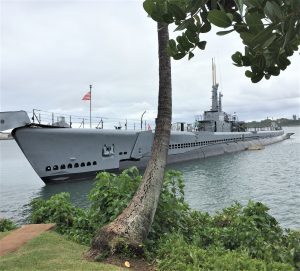
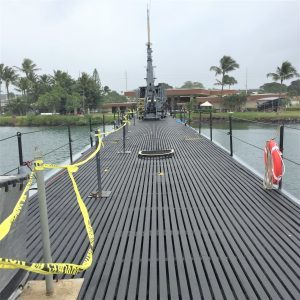
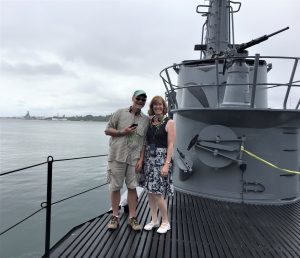
Below decks, you’re immediately struck by the confined quarters – although not nearly as cramped aboard the German submarine U-505 that we visited recently in Chicago (I’ll share about that visit here in March). No space is wasted on board a submarine. Note the crew berthing stashed between stored torpedoes!
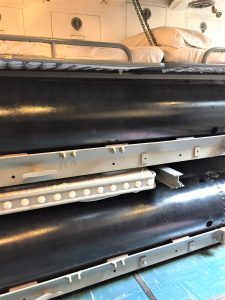
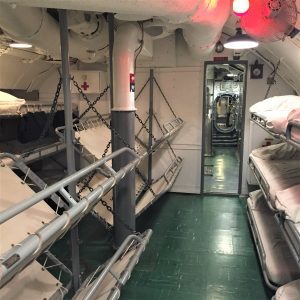
Submarines performed many roles during World War II – delivering commandos and supplies, rescuing downed airmen, and performing reconnaissance. However, the main role was to sink enemy ships. Torpedoes were the primary weapon used, but the deck guns were also frequently used.
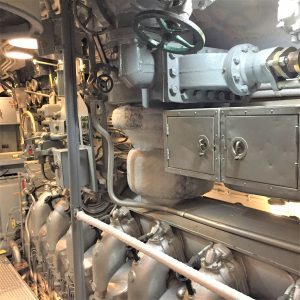
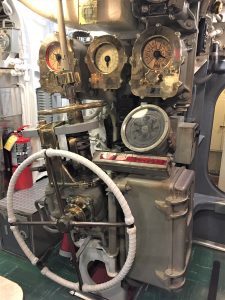
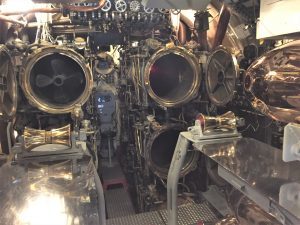
USS Missouri
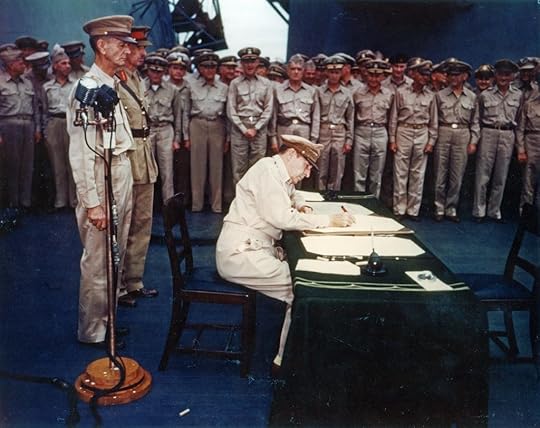
Gen. Douglas MacArthur signing the Japanese surrender documents aboard USS Missouri, 2 Sept 1945 (US National Archives)
The “Mighty Mo” was commissioned in June 1944 and served in the Pacific, participating in the bombardment of Iwo Jima, Okinawa, and the Japanese home islands. But she’s most famous for serving as the site of the surrender of Japan which officially ended World War II on September 2, 1945. Admiral Chester Nimitz and General Douglas MacArthur headed the US delegation, and high-ranking military men from Britain, China, Australia, New Zealand, Canada, France, the Netherlands, and the USSR were present to receive the Japanese surrender. Almost four years after the attack on Pearl Harbor, the war in the Pacific finally came to an end.
Today the USS Missouri is a beautiful museum ship at Pearl Harbor, her guns angled as if guarding the USS Arizona Memorial.
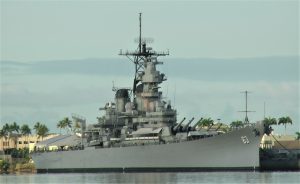
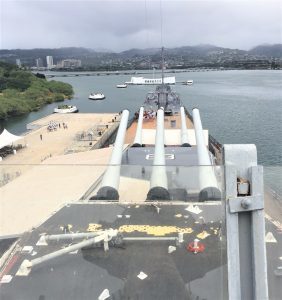
Both guided and self-guided tours are available for the USS Missouri. The approach to the ship is marked by flags and a statue of Admiral Chester Nimitz. A statue of the “Kissing Sailor” is a nice touch – a reminder of the joy in America on V-J Day when the war was over.
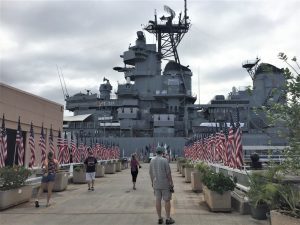
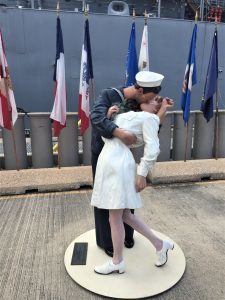
The main deck is dominated by the battleship’s massive 16-inch gun batteries. You can also explore the superstructure and below decks.
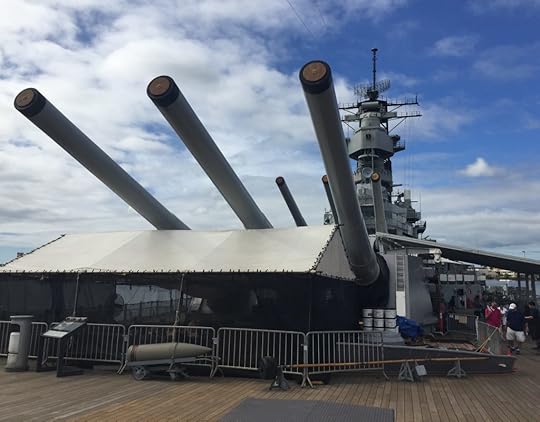
Forward main battery of the battleship USS Missouri, Pearl Harbor, Hawaii (Photo: Sarah Sundin, 7 Nov 2016)
The highlight of the tour is seeing the exact spot where the surrender documents were signed, as well as replicas of the documents.
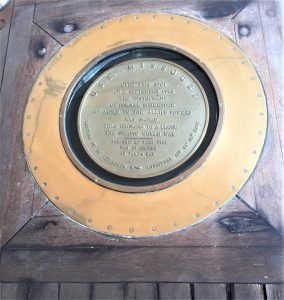
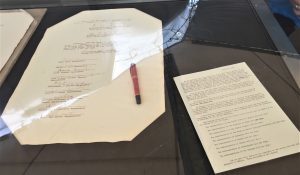
Thank you for joining me on my tour! And please visit the other posts – you can enter the giveaway on each of the three posts for three chances at winning:
Day 1: The Role of Aviation During the Attack – Pictures from the Pacific Aviation Museum
Day 2: The US Navy’s Role at Pearl Harbor – Pictures from the USS Arizona Memorial
Today in World War II History—Dec. 9, 1941

US poster, WWII
75 Years Ago—Dec. 9, 1941: Soviets retake Tikhvin, Russia, allowing easier supplying of Leningrad.
Japanese invade Gilbert Islands, landing on Tarawa and Makin.
Japanese occupy Bangkok, Thailand.
New England and New York City have first air raid alert; schools and defense plants are evacuated.
December 8, 2016
Today in World War II History—Dec. 8, 1941

President Roosevelt delivering the “Day of Infamy” speech, 8 Dec 1941 (Public domain via WW2 Database)
75 Years Ago—Dec. 8, 1941: President Roosevelt makes “date which will live in infamy” speech to Congress about the Pearl Harbor attack.
US House votes 388-1, Senate 82-0 to declare war on Japan; Roosevelt signs at 5:10 pm.
Japanese forces land in Thailand and Malaya.
Air raid alerts occur in San Francisco; in Seattle, a mob throws rocks at lights to enforce the blackout.
December 7, 2016
Remember Pearl Harbor – Tour & Commemorative Giveaway – Day 2
 Today marks the 75th anniversary of the attack on Pearl Harbor that launched the United States into World War II. Last month I was privileged to visit Pearl Harbor with my husband. This week I’m sharing photographs from our visit, plus some historical background. In addition, I’m giving away some commemorative items from Pearl Harbor – the official 75th anniversary commemorative ornament, Pearl Harbor: The Way It Was by Scott C.S. Stone, and a pen.
Today marks the 75th anniversary of the attack on Pearl Harbor that launched the United States into World War II. Last month I was privileged to visit Pearl Harbor with my husband. This week I’m sharing photographs from our visit, plus some historical background. In addition, I’m giving away some commemorative items from Pearl Harbor – the official 75th anniversary commemorative ornament, Pearl Harbor: The Way It Was by Scott C.S. Stone, and a pen.
To enter the giveaway, leave a comment on any of the three posts or send me an email at sarah [at] sarahsundin [dot] com – you have three chances to win. The giveaway ends Sunday, December 11, 2016, and I’ll announce the winner here on my blog on Monday, December 12, 2016.

Sarah Sundin at Pearl Harbor, Hawaii, 7 Nov 2016 (Photo: Sarah Sundin)
I hope these posts help you reflect on the gravity of the attack and the sacrifice of the 2459 servicemen and civilians who died that day. Let’s never forget the lessons of that day.
On Monday I shared pictures from the Pacific Aviation Museum. Today, I’ll share from the USS Arizona Memorial, and on Friday about the submarine USS Bowfin and the battleship USS Missouri, where the Japanese signed the surrender documents officially ending World War II on Sept. 2, 1945.
The US Navy’s Role at Pearl Harbor
The United States established a naval station at Pearl Harbor in 1899, and in May 1940, President Franklin Roosevelt moved Pacific Fleet Headquarters from San Diego to Pearl Harbor as a deterrent to Japanese aggression. Such a concentration of capital ships became a tempting target as Japanese military leaders hoped to wipe out American naval strength in the Pacific so they could carry out their conquests unmolested.
On December 7, 1941, 353 Japanese planes took off from aircraft carriers north of Hawaii in a daring surprise attack. However, the first shot that day was actually fired by an American ship – and the first loss that day was Japanese. At 0645, destroyer USS Ward detected a Japanese midget submarine off the entrance to Pearl Harbor – and sank it with assistance from a Navy PBY Catalina aircraft. However, word of this contact did not spread in time.
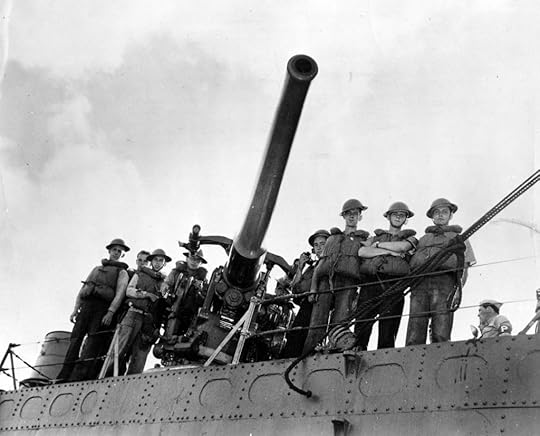
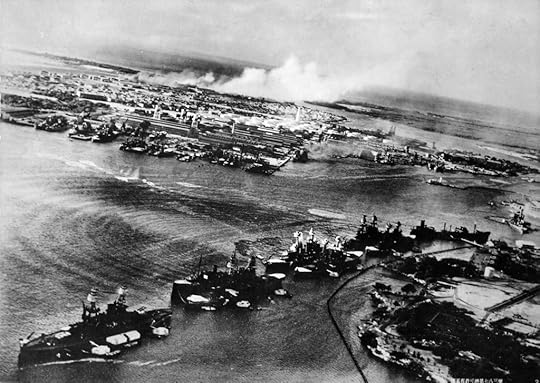
At 0745, the first wave of aircraft attacked, concentrating first on airfields and then on Battleship Row, with the ships lined up neatly – to prevent sabotage, which was considered a greater danger than an air raid. At 0854, the second wave hit. By the end of the attack, five battleships had been sunk–the Arizona, Oklahoma, California, West Virginia, and Utah. The battleship USS Nevada managed to get underway and hoped to clear the channel, but damage forced the captain to make the brave and dangerous decision to beach the gigantic ship. This saved the Nevada, which went on to bombard the landing beaches of Normandy on D-Day. The California and West Virginia would eventually be raised and repaired, and the Oklahoma was salvaged, but the wrecks of the Arizona and Utah remain where they sank and have since become memorials.
Of the 2459 servicemen and civilians killed that day, 2008 were members of the US Navy, and 1177 were on the USS Arizona.
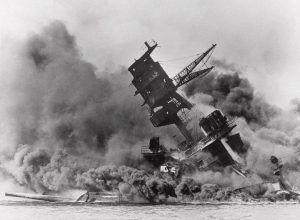
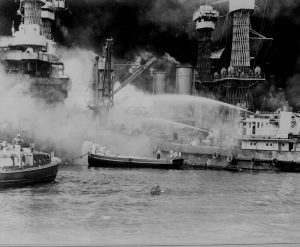
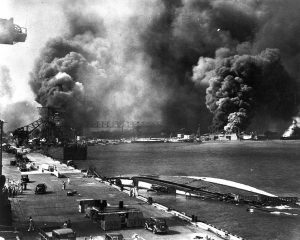
USS Arizona Memorial
Each year 2 million people visit the USS Arizona Memorial. This year, my husband and I were honored to join them. The tour starts at the visitor center with many sites to see and a museum. At the designated tour time, visitors watch a well-done and touching movie about the attack. Navy-run shuttle boats transport visitors to the memorial.
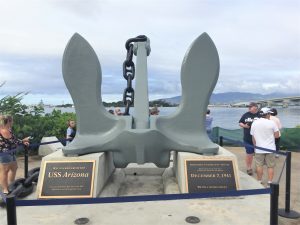
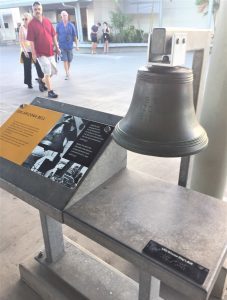
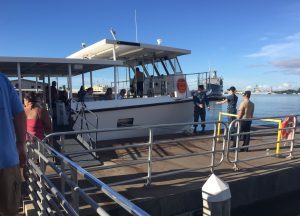
The striking white building of the memorial straddles the sunken Arizona. An air of quiet reverence settles as you disembark and enter the memorial. Knowledgeable docents are present to answer questions and educate the public.
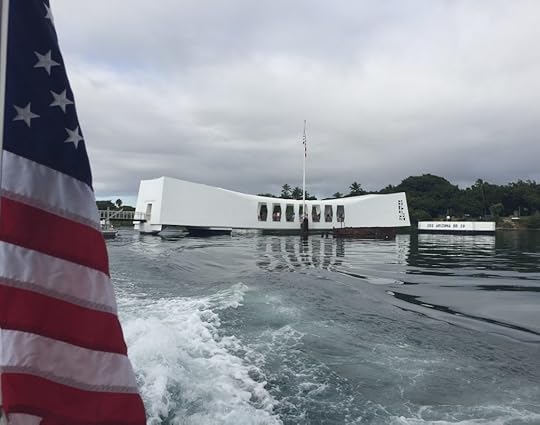
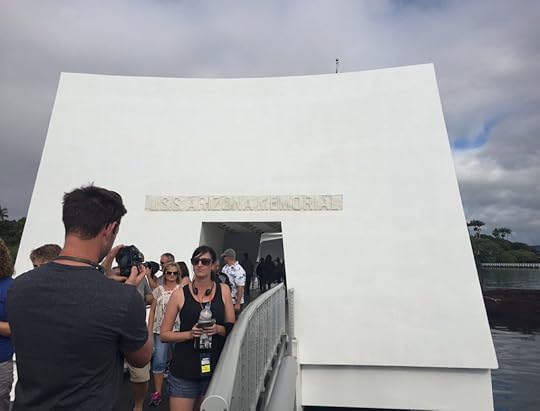
Gazing out the side windows, you look down at the submerged superstructure of the battleship, and the immensity of the loss is striking. Seventy-five years after the ship was sunk, oil from her tanks is still leaking to the surface, creating a sheen to the water.
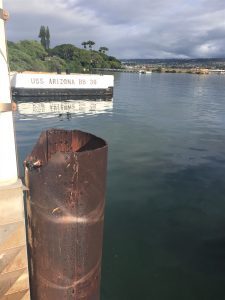
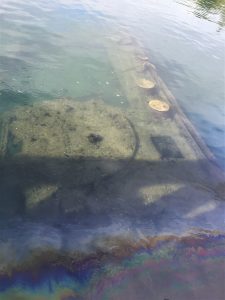
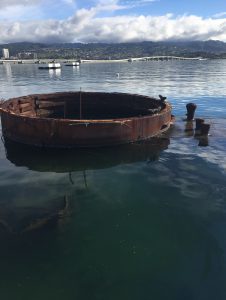
Last you enter a quiet room with a towering wall engraved with the names of the 1177 sailors and Marines who died in the attack on the Arizona. Survivors who have later had their ashes interred with their former shipmates have their names engraved on two smaller plaques below. This is incredibly moving sight, realizing the truth that those 1177 men were sons, grandsons, brothers, uncles, husbands, fathers, and friends, who left loved ones behind.
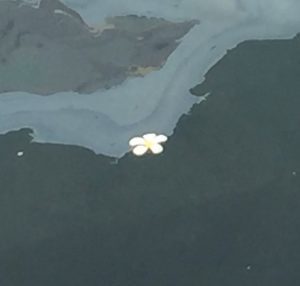
On this Pearl Harbor Day, let’s remember.
And please visit the other posts:
Day 1: The Role of Aviation During the Attack – Pictures from the Pacific Aviation Museum
Day 3: From Tragedy to Triumph – Pictures from the USS Bowfin and the USS Missouri
Today in World War II History—Dec. 7, 1941
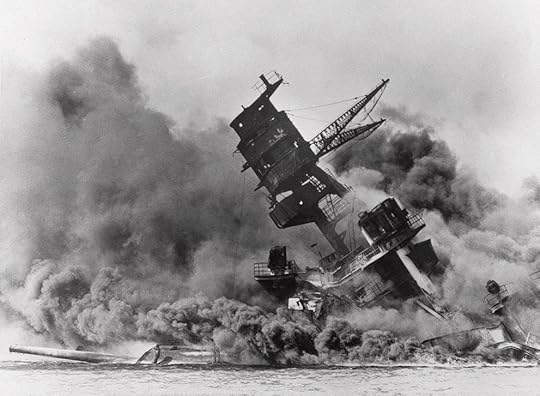
Battleship USS Arizona burning at Pearl Harbor, 7 Dec 1941 (US National Archives)

Lt. Karl T. Barthelmess’ B-17E at Hickam Air Field, after landing safely during the Japanese air raid, 7 Dec 1941; note smoke rising from Pearl Harbor (US National Archives)
75 Years Ago—Dec. 7, 1941: Japanese attack Pearl Harbor at 0755, killing 2402 military personnel and 57 civilians. Japanese aircraft sink US battleships Arizona, Oklahoma, West Virginia, California, Utah (which had been converted to an auxiliary), and damage battleship USS Nevada.
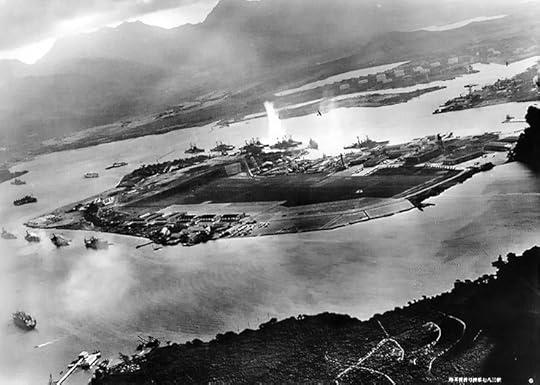
Aerial view of Ford Island in Pearl Harbor during the Japanese attack, 7 Dec 1941; photo taken from a Japanese aircraft (US Naval History & Heritage Command)
At Pearl Harbor, destroyer USS Ward fires the first shot, sinking a Japanese midget sub at 0645.
December 6, 2016
Today in World War II History—Dec. 6, 1941
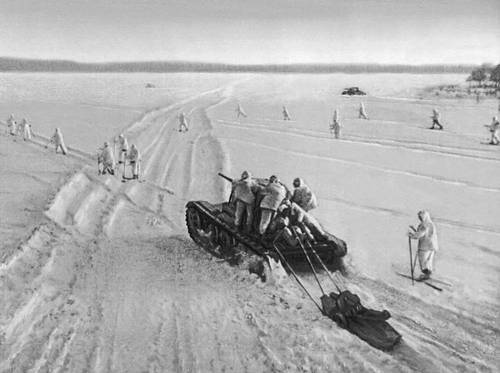
Soviet troops advancing on skis, near Moscow, Russia, Dec 1941 (Public domain via WW2 Database)
75 Years Ago—Dec. 6, 1941: Soviet Gen. Georgi Zhukov launches a counteroffensive north of Moscow against the German army.
Battleships USS Oklahoma and USS Nevada arrive at Pearl Harbor.
December 5, 2016
Remember Pearl Harbor – Tour & Commemorative Giveaway – Day 1
 This week marks the 75th anniversary of the attack on Pearl Harbor that launched the United States into World War II. Last month I was privileged to visit Pearl Harbor with my husband. This week I’m sharing photographs from our visit, plus some historical background. In addition, I’m giving away some commemorative items from Pearl Harbor – the official 75th anniversary commemorative ornament, Pearl Harbor: The Way It Was by Scott C.S. Stone, and a pen.
This week marks the 75th anniversary of the attack on Pearl Harbor that launched the United States into World War II. Last month I was privileged to visit Pearl Harbor with my husband. This week I’m sharing photographs from our visit, plus some historical background. In addition, I’m giving away some commemorative items from Pearl Harbor – the official 75th anniversary commemorative ornament, Pearl Harbor: The Way It Was by Scott C.S. Stone, and a pen.
To enter the giveaway, leave a comment on any of the three posts or send me an email at sarah [at] sarahsundin [dot] com – you have three chances to win. The giveaway ends Sunday, December 11, 2016, and I’ll announce the winner here on my blog on Monday, December 12, 2016.
I hope these posts help you reflect on the gravity of the attack and the sacrifice of the 2459 servicemen and civilians who died that day. Let’s never forget the lessons of that day.

Sarah Sundin at Pearl Harbor, Hawaii, 7 Nov 2016 (Photo: Sarah Sundin)
Today I’ll share pictures from the Pacific Aviation Museum. On Wednesday, I’ll share from the USS Arizona Memorial, and on Friday about the submarine USS Bowfin and the battleship USS Missouri, where the Japanese signed the surrender documents officially ending World War II on Sept. 2, 1945.
Aviation during the Pearl Harbor Attack
The Japanese attack on Pearl Harbor on December 7, 1941 is most known for its disastrous effect on the US Navy’s Pacific Fleet. However, aviation played an important role.
The attack itself, of course, was carried out by aircraft – 353 Japanese carrier-based fighters and bombers in two waves. A handful of American planes were able to take off and defend Pearl Harbor, downing a few Japanese planes. In all, 29 Japanese planes were lost. But 188 American planes were lost, most of them destroyed on the ground.
On December 6, 1941, twelve B-17 Flying Fortresses left Hamilton Field, north of San Francisco, bound for the Philippines, via Hickam Field at Pearl Harbor. My great-uncle, Roderick M. Stewart, served as a second lieutenant on one of the crews. Weighted down by gasoline for the thirteen-hour flight, they were unable to carry guns or ammunition. But why would they need them? The United States was at peace.
The next morning, the B-17s arrived in the middle of the Japanese attack. The bombers dodged both enemy bullets and friendly antiaircraft shells and landed where they could on fields cratered by bombs. Eight landed at Hickam Field, two at Haleiwa Field, one at Bellows Field, and one put down on Kahuku Golf Course. One of the planes was destroyed, and three were damaged. Six men were wounded, and one man was killed. My great-uncle went on to fly combat tours from Australia and England.
In an interesting historical side note, the brand-new Opana Radar Station detected the Japanese planes coming in for the attack, but the officer in charge, who had started duty that very morning, dismissed the findings, certain the radar blips depicted the expected B-17s. We’ll never know if an extra half hour of preparation could have prevented some of the day’s tragedy.
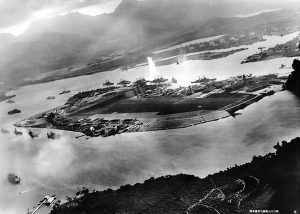
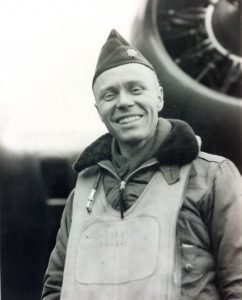
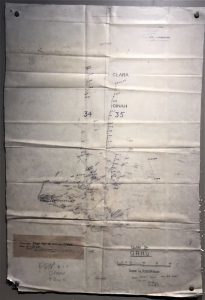
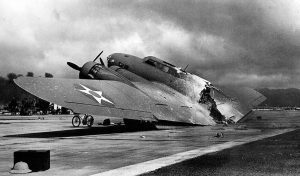
The Pacific Aviation Museum
One of the Pearl Harbor Historic Sites is the excellent Pacific Aviation Museum. Located in Hangar 37 on Ford Island in Pearl Harbor, this museum chronicles the role of aviation in the attack on Pearl Harbor and throughout World War II in the Pacific. Nicely done with aircraft in dioramas and plenty of explanatory material, this museum is well worth a visit! The buildings date from the WWII-era and bear the scars of the attack. Please note the bullet holes from the attack in the windows of Hangar 79!
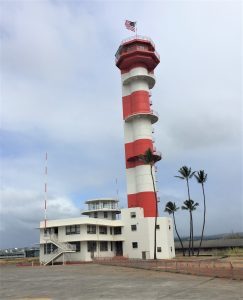
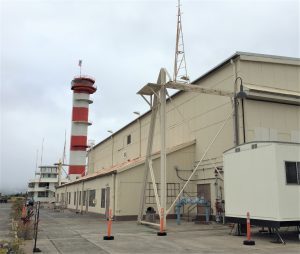
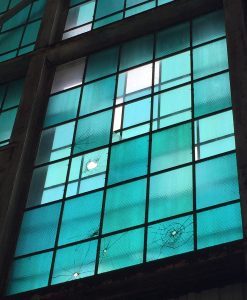
In the main building, Hangar 37, you first see exhibits about the attack on Pearl Harbor on December 7, 1941, including a Japanese A6M Zero fighter and a US P-40 Warhawk fighter. The P-40s were responsible for downing several Japanese aircraft.
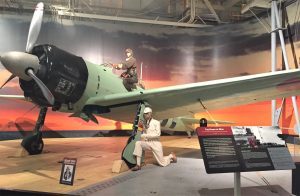
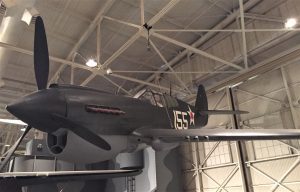
The museum follows the war in the Pacific. An exhibit commemorates the daring Doolittle Raid on Tokyo by carrier-based B-25 Mitchell medium bombers – which were not meant to be carrier aircraft – led by the famous Gen. Jimmy Doolittle. Other exhibits tell of the Battle of Midway (the turning point of the battle in the Pacific) and the “Cactus Air Force” which fought valiantly on Guadalcanal.
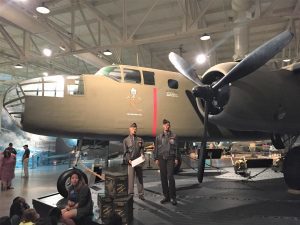
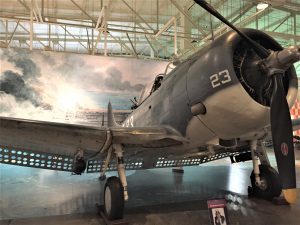
Hangar 79 is a treat. Full of historic aircraft, not just from World War II, it also contains a restoration shop. One of the aircraft undergoing restoration is the Swamp Ghost. This B-17 Flying Fortress served with the US 7th Bombardment Group based in Townsville, Australia – my great-uncle’s group! After a raid on Rabaul, New Britain on February 23, 1942, the plane was damaged by enemy fighters and made a forced landing in a swamp on New Guinea. The crew made an astounding six-week trek through the jungle to safety. The B-17 lay in that swamp until rescued by aviation enthusiasts in 2006. I’m privileged to have read a manuscript about the Swamp Ghost written by one of my great-uncle’s colleagues, Glen Spieth, written in 1986 when they were hoping to recover this plane. I know Uncle Rod and the men of the 7th BG would be thrilled to see this plane being so lovingly restored as they wanted. It was an honor for me to see such an amazing piece of history.
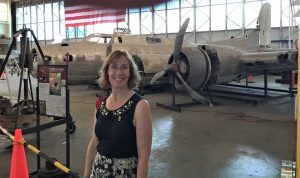
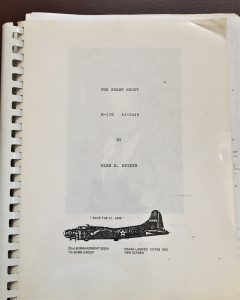
Please return on Wednesday, December 7 – Pearl Harbor Day – for pictures of the USS Arizona Memorial.
Today in World War II History—Dec. 5, 1941
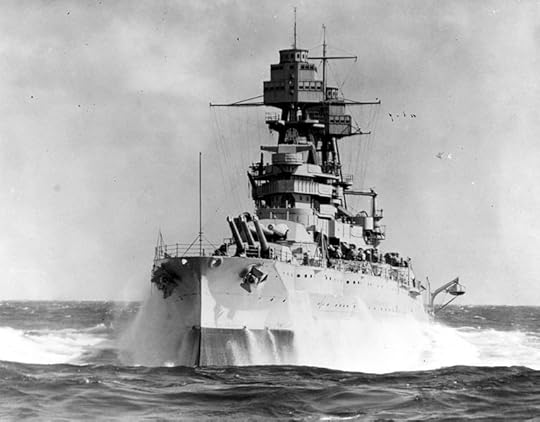
USS Arizona, 1930s (US Navy photo)
75 Years Ago—Dec. 5, 1941: Battleship USS Arizona arrives at Pearl Harbor.
USS Lexington departs with Marine aircraft for Midway, leaving no carriers at Pearl Harbor.
James J. Kilroy of Boston hired at Fore River Shipyard, Quincy MA to check work of riveters; his “Kilroy Was Here” mark on ships becomes legendary.
John Steinbeck’s Sea of Cortez is published.
December 4, 2016
Today in World War II History—Dec. 4, 1941
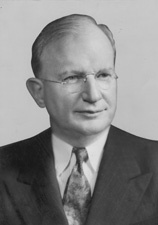
Sen. Burton Wheeler (US Senate Historical Office)
75 Years Ago—Dec. 4, 1941: Chicago Tribune and Washington Times-Herald publish news of classified unapproved US Victory Program war plans, leaked to the papers by isolationist Sen. Burton Wheeler, creating cries of warmongering among isolationists.
Interventionist Chicago Sun first published as foil for isolationist Chicago Tribune.
National Foundation for Infantile Paralysis approves Sister Kenny’s controversial massage treatment for polio.
December 3, 2016
Today in World War II History—Dec. 3, 1941
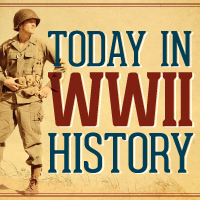 75 Years Ago—Dec. 3, 1941: Hitler issues Rationalization Decree, urging modern efficient mass production.
75 Years Ago—Dec. 3, 1941: Hitler issues Rationalization Decree, urging modern efficient mass production.
In South Atlantic, U-124 sinks unarmed US freighter Sagadahoc (1 killed), sixth US ship sunk in the Atlantic while the US remained neutral.



